check oil Lancia Ypsilon 2011 Owner handbook (in English)
[x] Cancel search | Manufacturer: LANCIA, Model Year: 2011, Model line: Ypsilon, Model: Lancia Ypsilon 2011Pages: 299, PDF Size: 13.35 MB
Page 67 of 299
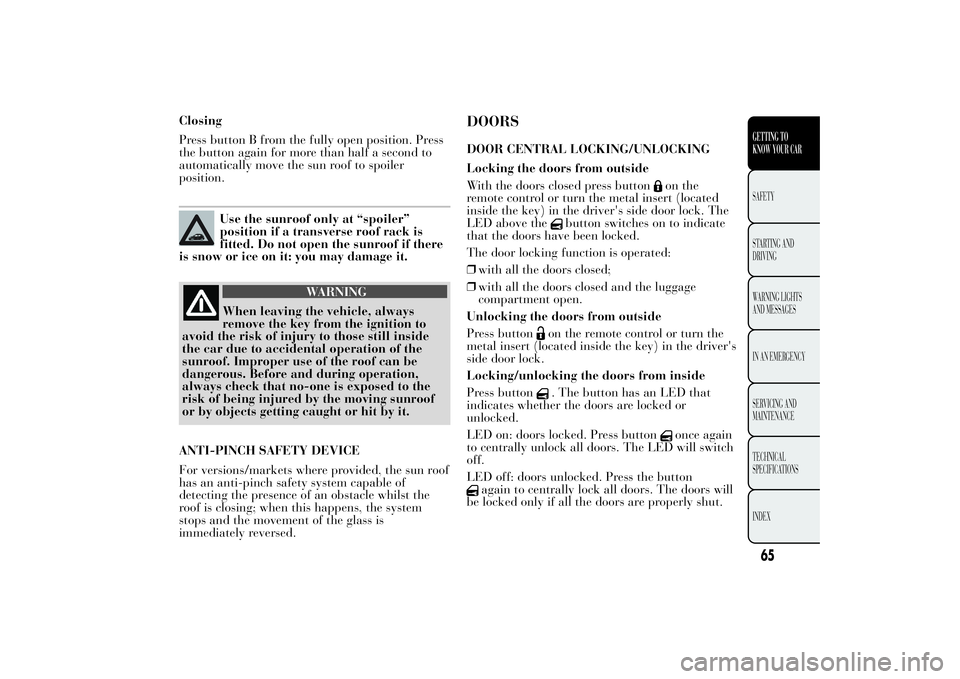
Closing
Press button B from the fully open position. Press
the button again for more than half a second to
automatically move the sun roof to spoiler
position.
Use the sunroof only at “spoiler”
position if a transverse roof rack is
fitted. Do not open the sunroof if there
is snow or ice on it: you may damage it.
WARNING
When leaving the vehicle, always
remove the key
from the ignition to
avoid the risk of injury to those still inside
the car due to accidental operation of the
sunroof. Improper use of the roof can be
dangerous. Before and during operation,
always check that no-one is exposed to the
risk of being injured by the moving sunroof
or by objects getting caught or hit by it.
ANTI-PINCH SAFETY DEVICE
For versions/markets where provided, the sun roof
has an anti-pinch safety system capable of
detecting the presence of an obstacle whilst the
roof is closing; when this happens, the system
stops and the movement of the glass is
immediately reversed.
DOORSDOOR CENTRAL LOCKING/UNLOCKING
Locking the doors from outside
With the doors closed press button
on the
remote control or turn the metal insert (located
inside the key) in the driver's side door lock. The
LED above the
button switches on to indicate
that the doors have been locked.
The door locking function is operated:
❒with all the doors closed;
❒with all the doors closed and the luggage
compartment open.
Unlocking the doors from outside
Press button
on the remote control or turn the
metal insert (located inside the key) in the driver's
side door lock.
Locking/unlocking the doors from inside
Press button. The button has an LED that
indicates whether the doors are locked or
unlocked.
LED on: doors locked. Press button
once again
to centrally unlock all doors. The LED will switch
off.
LED off: doors unlocked. Press the button
again to centrally lock all doors. The doors will
be locked only if all the doors are properly shut.
65GETTING TO
KNOW YOUR CARSAFETY
STARTING
AND
DRIVING
WARNING LIGHTS
AND MESSAGES
IN AN EMERGENCY
SERVICING AND
MAINTENANCE
TECHNICAL
SPECIFICATIONS
INDEX
Page 147 of 299

WARNING
A failure of the
warning light is
indicated by warning light
switching on. In addition, the airbag
system automatically disables the airbags on
the passenger's side (both front and side
airbags where provided). Before continuing,
contact a Lancia Dealership immediately
to have the system checked.
UNFASTENED SEAT BELTS (red)
(for versions/markets, where provided)
The warning light switches on constantly with the
car stationary and the driver's side or passenger
side seat belt (when the passenger is present)
not fastened. The warning light will flash and a
buzzer will sound if the car is in motion and
the front seat belts are not correctly fastened.
Contact a Lancia Dealership if you wish to
permanently deactivate the S.B.R. (Seat Belt
Reminder) system buzzer. The system can be
reactivated using the Setup menu (see the
description in the chapter "Knowing your car").
LOW BATTERY CHARGE (red)
(for versions/markets, where provided)
When the ignition key is moved to MAR, the
warning light switches on but should switch off as
soon as the engine is started (with the engine
idling, a brief delay can be expected).
If the warning light (or, on some versions, a
message and a symbol on the display) remains on
constantly or flashing, contact a Lancia
Dealership.CONTINUOUSLY ON: LOW ENGINE
OIL PRESSURE (red)
ON FLASHING: ENGINE OIL
DETERIORATED
(only Diesel versions with DPF - red)
When the ignition key is moved to MAR, the
warning light switches on but should switch off as
soon as the engine is started.
1. Insufficient engine oil pressure
The warning light switches on constantly together
(for versions/markets, where provided) with a
message on the display when the system detects
that the engine oil pressure is too low.
145GETTING TO KNOW
YOUR CAR
SAFETY
STARTING AND
DRIVINGWARNING LIGHTS
AND
MESSAGESIN AN
EMERGENCY
SERVICING AND
MAINTENANCE
TECHNICAL
SPECIFICA
TIONS
INDEX
Page 201 of 299
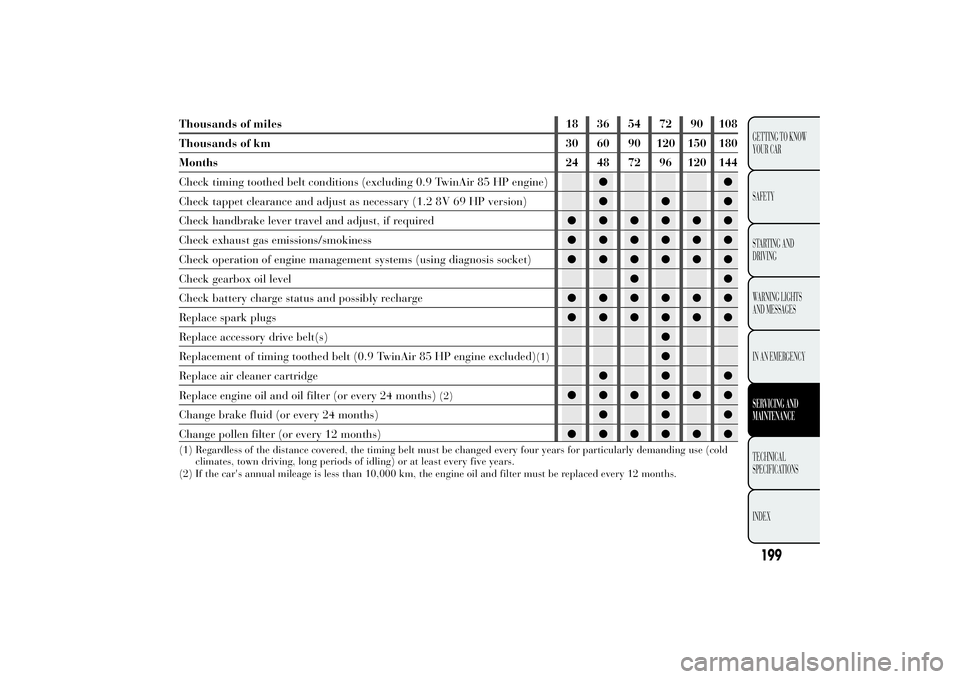
Thousands of miles 18 36 54 72 90 108
Thousands of km 30 60 90 120 150 180
Months 24 48 72 96 120 144
Check timing toothed belt conditions (excluding 0.9 TwinAir 85 HP engine)●●
Check tappet clearance and adjust as necessary (1.2 8V 69 HP version)●●●
Check handbrake lever travel and adjust, if required●●●●●●
Check exhaust gas emissions/smokiness●●●●●●
Check operation of engine management systems (using diagnosis socket)●●●●●●
Check gearbox oil level●●
Check battery charge status and possibly recharge●●●●●●
Replace spark plugs●●●●●●
Replace accessory drive belt(s)●
Replacement of timing toothed belt (0.9 TwinAir 85 HP engine excluded)
(1)
●
Replace air cleaner cartridge●●●
Replace engine oil and oil filter (or every 24 months)
(2)
●●●●●●
Change brake fluid (or every 24 months)●●●
Change pollen filter (or every 12 months)●●●●●●
(1) Regardless of the distance covered, the timing belt must be changed every four years for particularly demanding use (cold
climates, town driving, long periods of idling) or at least every five years.
(2) If the car's annual mileage is less than 10,000 km, the engine oil and filter must be replaced every 12 months.
199GETTING TO KNOW
YOUR CAR
SAFETY
STARTING AND
DRIVING
WARNING LIGHTS
AND MESSAGES
IN AN EMERGENCYSERVICING AND
MAINTENANCETECHNICAL
SPECIFICA
TIONS
INDEX
Page 203 of 299
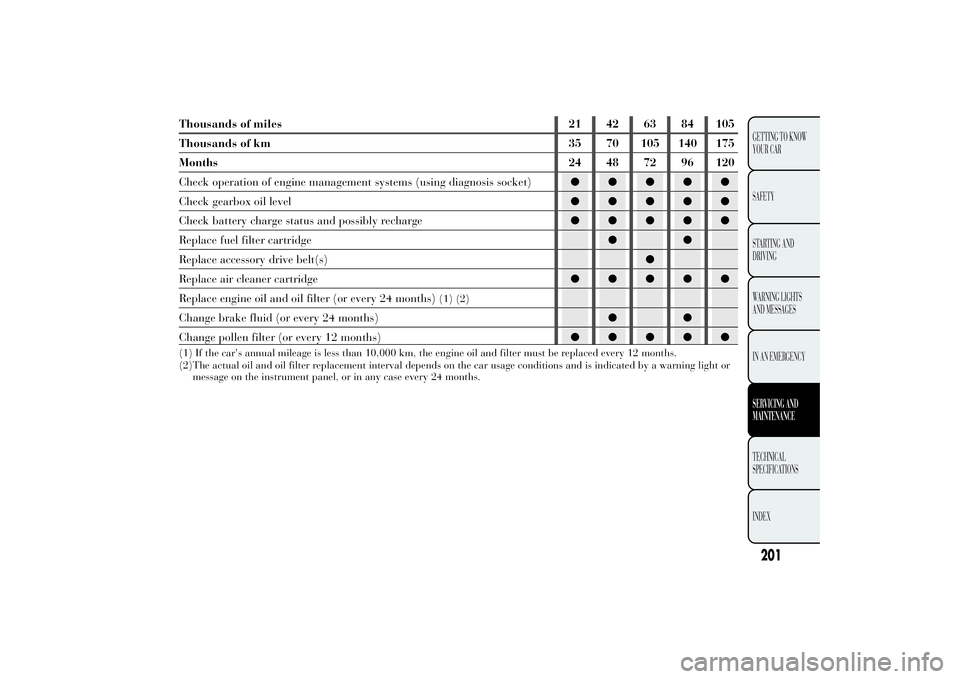
Thousands of miles 21 42 63 84 105
Thousands of km 35 70 105 140 175
Months 24 48 72 96 120
Check operation of engine management systems (using diagnosis socket)●●●●●
Check gearbox oil level●●●●●
Check battery charge status and possibly recharge●●●●●
Replace fuel filter cartridge●●
Replace accessory drive belt(s)●
Replace air cleaner cartridge●●●●●
Replace engine oil and oil filter (or every 24 months)
(1) (2)
Change brake fluid (or every 24 months)●●
Change pollen filter (or every 12 months)●●●●●(1) If the car's annual mileage is less than 10,000 km, the engine oil and filter must be replaced every 12 months.
(2)The actual oil and oil filter replacement interval depends on the car usage conditions and is indicated by a warning light or
message on the instrument panel, or in any case every 24 months.
201GETTING TO KNOW
YOUR CAR
SAFETY
STARTING AND
DRIVING
WARNING LIGHTS
AND MESSAGES
IN AN EMERGENCYSERVICING AND
MAINTENANCETECHNICAL
SPECIFICA
TIONS
INDEX
Page 204 of 299
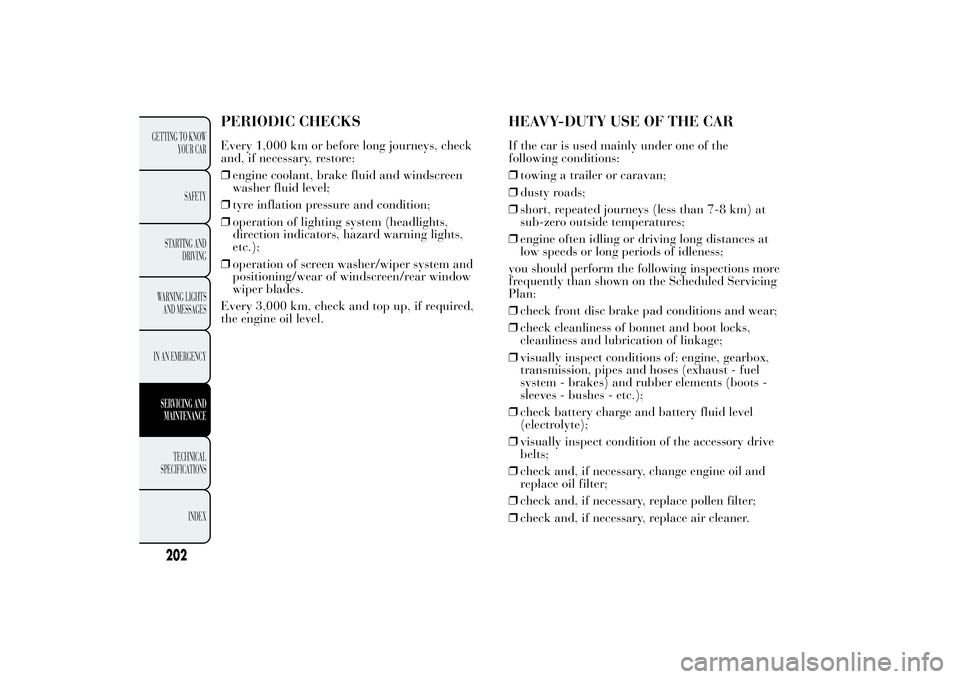
PERIODIC CHECKSEvery 1,000 km or before long journeys, check
and, if necessary, restore:
❒engine coolant, brake fluid and windscreen
washer fluid level;
❒tyre inflation pressure and condition;
❒operation of lighting system (headlights,
direction indicators, hazard warning lights,
etc.);
❒operation of screen washer/wiper system and
positioning/wear of windscreen/rear window
wiper blades.
Every 3,000 km, check and top up, if required,
the engine oil level.
HEAVY-DUTY USE OF THE CARIf the car is used mainly under one of the
following conditions:
❒towing a trailer or caravan;
❒dusty roads;
❒short, repeated journeys (less than 7-8 km) at
sub-zero outside temperatures;
❒engine often idling or driving long distances at
low speeds or long periods of idleness;
you should perform the following inspections more
frequently than shown on the Scheduled Servicing
Plan:
❒check front disc brake pad conditions and wear;
❒check cleanliness of bonnet and boot locks,
cleanliness and lubrication of linkage;
❒visually inspect conditions of: engine, gearbox,
transmission, pipes and hoses (exhaust - fuel
system - brakes) and rubber elements (boots -
sleeves - bushes - etc.);
❒check battery charge and battery fluid level
(electrolyte);
❒visually inspect condition of the accessory drive
belts;
❒check and, if necessary, change engine oil and
replace oil filter;
❒check and, if necessary, replace pollen filter;
❒check and, if necessary, replace air cleaner.
202
GETTING TO KNOW
YOUR CAR
SAFETY
STARTING AND
DRIVING
WARNING LIGHTS
AND MESSAGES
IN AN EMERGENCYSERVICING AND
MAINTENANCE
TECHNICAL
SPECIFICA
TIONS
INDEX
Page 209 of 299
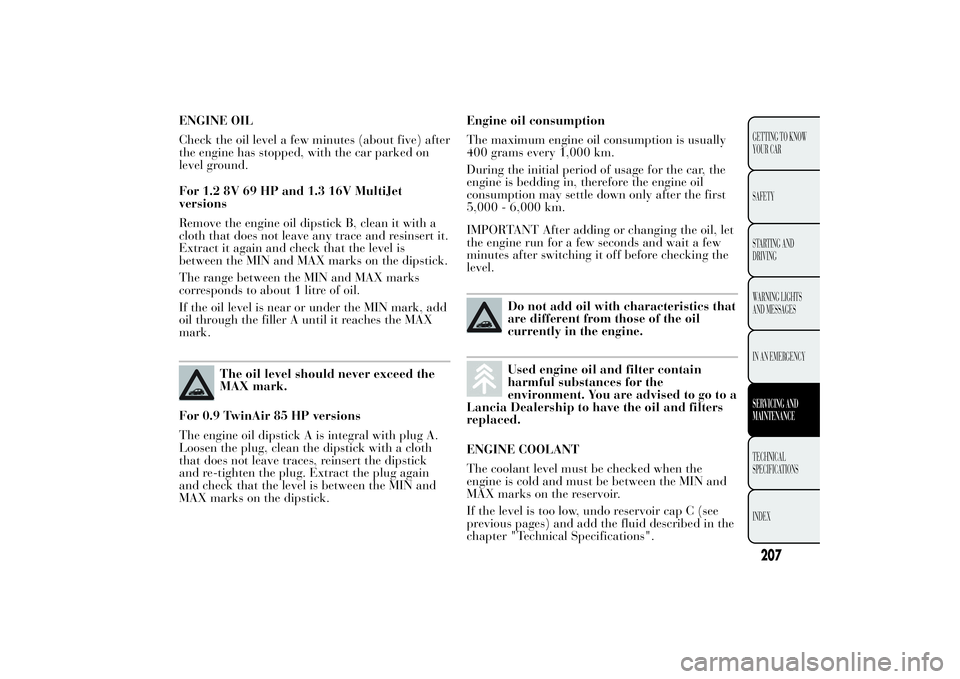
ENGINE OIL
Check the oil level a few minutes (about five) after
the engine has stopped, with the car parked on
level ground.
For 1.2 8V 69 HP and 1.3 16V MultiJet
versions
Remove the engine oil dipstick B, clean it with a
cloth that does not leave any trace and resinsert it.
Extract it again and check that the level is
between the MIN and MAX marks on the dipstick.
The range between the MIN and MAX marks
corresponds to about 1 litre of oil.
If the oil level is near or under the MIN mark, add
oil through the filler A until it reaches the MAX
mark.
The oil level should never exceed the
MAX mark.
For 0.9 TwinAir 85 HP versions
The engine oil dipstick A is integral with plug A.
Loosen the plug, clean the dipstick with a cloth
that does not leave traces, reinsert the dipstick
and re-tighten the plug. Extract the plug again
and check that the level is between the MIN and
MAX marks on the dipstick.Engine oil consumption
The maximum engine oil consumption is usually
400 grams every 1,000 km.
During the initial period of usage for the car, the
engine is bedding in, therefore the engine oil
consumption may settle down only after the first
5,000 - 6,000 km.
IMPORTANT After adding or changing the oil, let
the engine run for a few seconds and wait a few
minutes after switching it off before checking the
level.
Do not add oil with characteristics that
are different from those of the oil
currently in the engine.Used engine oil and filter contain
harmful substances for the
environment. You are advised to go to a
Lancia Dealership to have the oil and filters
replaced.
ENGINE COOLANT
The coolant level must be checked when the
engine is cold and must be between the MIN and
MAX marks on the reservoir.
If the level is too low, undo reservoir cap C (see
previous pages) and add the fluid described in the
chapter "Technical Specifications".
207GETTING TO KNOW
YOUR CAR
SAFETY
STARTING AND
DRIVING
WARNING LIGHTS
AND MESSAGES
IN AN EMERGENCYSERVICING AND
MAINTENANCETECHNICAL
SPECIFICA
TIONS
INDEX
Page 220 of 299
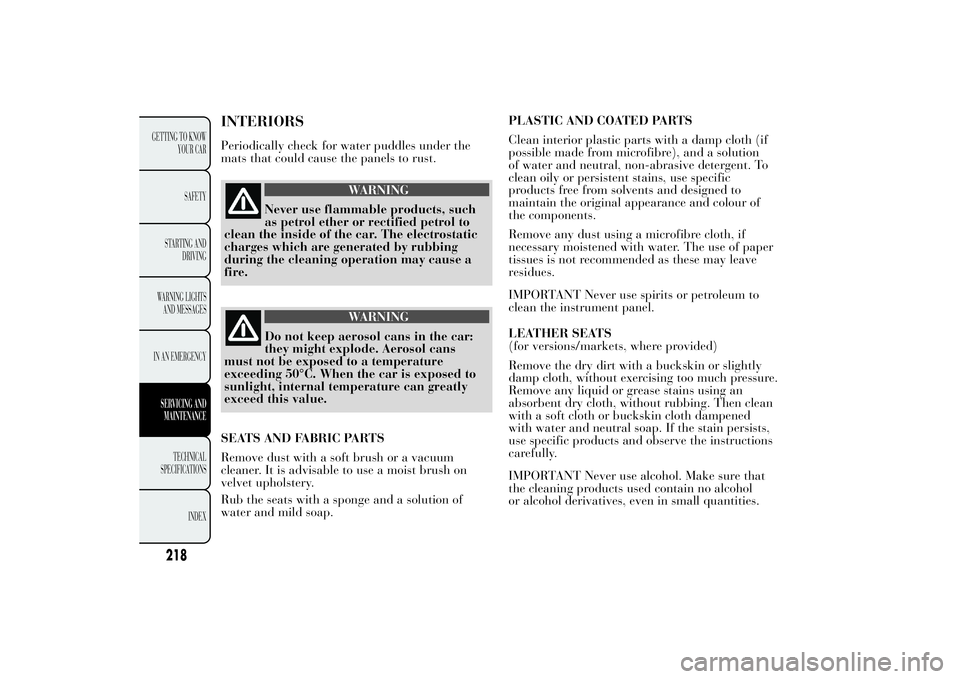
INTERIORSPeriodically check for water puddles under the
mats that could cause the panels to rust.
WARNING
Never use flammable products, such
as petrol ether
or rectified petrol to
clean the inside of the car. The electrostatic
charges which are generated by rubbing
during the cleaning operation may cause a
fire.
WARNING
Do not keep aerosol cans in the car:
they might explode.
Aerosol cans
must not be exposed to a temperature
exceeding 50°C. When the car is exposed to
sunlight, internal temperature can greatly
exceed this value.
SEATS AND FABRIC PARTS
Remove dust with a soft brush or a vacuum
cleaner. It is advisable to use a moist brush on
velvet upholstery.
Rub the seats with a sponge and a solution of
water and mild soap.PLASTIC AND COATED PARTS
Clean interior plastic parts with a damp cloth (if
possible made from microfibre), and a solution
of water and neutral, non-abrasive detergent. To
clean oily or persistent stains, use specific
products free from solvents and designed to
maintain the original appearance and colour of
the components.
Remove any dust using a microfibre cloth, if
necessary moistened with water. The use of paper
tissues is not recommended as these may leave
residues.
IMPORTANT Never use spirits or petroleum to
clean the instrument panel.
LEATHER SEATS
(for versions/markets, where provided)
Remove the dry dirt with a buckskin or slightly
damp cloth, without exercising too much pressure.
Remove any liquid or grease stains using an
absorbent dry cloth, without rubbing. Then clean
with a soft cloth or buckskin cloth dampened
with water and neutral soap. If the stain persists,
use specific products and observe the instructions
carefully.
IMPORTANT Never use alcohol. Make sure that
the cleaning products used contain no alcohol
or alcohol derivatives, even in small quantities.
218
GETTING TO KNOW
YOUR CAR
SAFETY
STARTING AND
DRIVING
WARNING LIGHTS
AND MESSAGES
IN AN EMERGENCYSERVICING AND
MAINTENANCE
TECHNICAL
SPECIFICA
TIONS
INDEX
Page 294 of 299
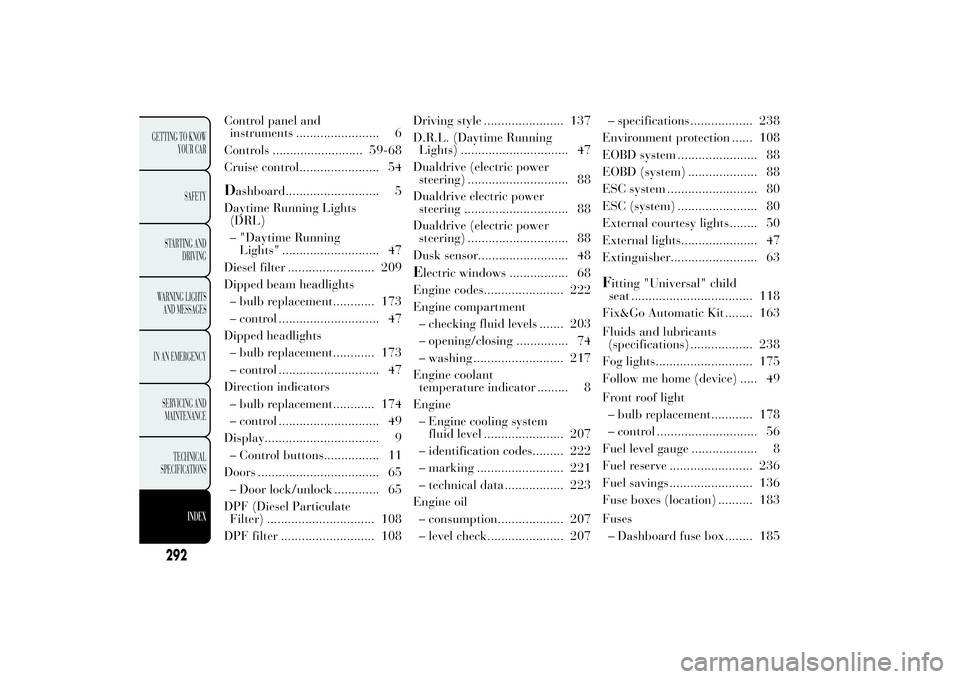
Control panel and
instruments ........................ 6
Controls .......................... 59-68
Cruise control....................... 54D
ashboard........................... 5
Daytime Running Lights
(DRL)
– "Daytime Running
Lights" ............................ 47
Diesel filter ......................... 209
Dipped beam headlights
– bulb replacement............ 173
– control ............................. 47
Dipped headlights
– bulb replacement............ 173
– control ............................. 47
Direction indicators
– bulb replacement............ 174
– control ............................. 49
Display................................. 9
– Control buttons................ 11
Doors ................................... 65
– Door lock/unlock ............. 65
DPF (Diesel Particulate
Filter) ............................... 108
DPF filter ........................... 108Driving style ....................... 137
D.R.L. (Daytime Running
Lights) ............................... 47
Dualdrive (electric power
steering) ............................. 88
Dualdrive electric power
steering .............................. 88
Dualdrive (electric power
steering) ............................. 88
Dusk sensor.......................... 48
Electric windows ................. 68
Engine codes....................... 222
Engine compartment
– checking fluid levels ....... 203
– opening/closing ............... 74
– washing .......................... 217
Engine coolant
temperature indicator ......... 8
Engine
– Engine cooling system
fluid level ....................... 207
– identification codes......... 222
– marking ......................... 221
– technical data ................. 223
Engine oil
– consumption................... 207
– level check...................... 207– specifications .................. 238
Environment protection ...... 108
EOBD system ....................... 88
EOBD (system) .................... 88
ESC system .......................... 80
ESC (system) ....................... 80
External courtesy lights ........ 50
External lights...................... 47
Extinguisher......................... 63
Fitting "Universal" child
seat ................................... 118
Fix&Go Automatic Kit ........ 163
Fluids and lubricants
(specifications) .................. 238
Fog lights............................ 175
Follow me home (device) ..... 49
Front roof light
– bulb replacement............ 178
– control ............................. 56
Fuel level gauge ................... 8
Fuel reserve ........................ 236
Fuel savings ........................ 136
Fuse boxes (location) .......... 183
Fuses
– Dashboard fuse box ........ 185
292
GETTING TO KNOW
YOUR CAR
SAFETY
STARTING AND
DRIVING
WARNING LIGHTS
AND MESSAGES
IN AN EMERGENCY
SERVICING AND
MAINTENANCE
TECHNICAL
SPECIFICATIONS
INDEX